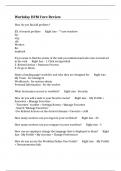Class notes
Extensive summary of lecture notes Perception
- Course
- Institution
- Book
This is a very extensive summary of all the lectures of the course perception. It is a really comprehensive summary containing all the important concepts spoken about in the lectures. There is also some additional information from the book to clarify some concepts or from the internet. There are a...
[Show more]




